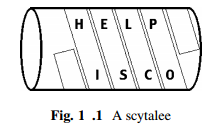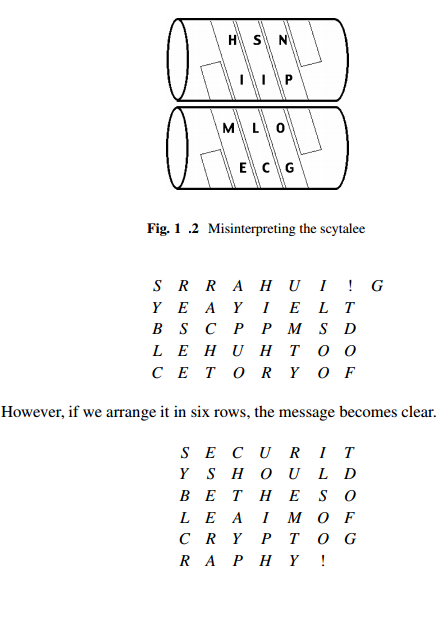


 تاريخ الرياضيات
تاريخ الرياضيات
 الرياضيات في الحضارات المختلفة
الرياضيات في الحضارات المختلفة 
 الرياضيات المتقطعة
الرياضيات المتقطعة
 الجبر
الجبر
 الهندسة
الهندسة 
 المعادلات التفاضلية و التكاملية
المعادلات التفاضلية و التكاملية 
 التحليل
التحليل
 علماء الرياضيات
علماء الرياضيات |
Read More
Date: 5-2-2016
Date: 5-2-2016
Date: 5-2-2016
|
Some 2500 years ago the Spartans during their wars used a special device to transport their secret messages. They took a staff called a scytalee (pronounced “sitterlee”), and wound a long, thin strip of parchment around it at an angle. They then wrote their message on the parchment, one letter on each width of parchment.
When the strip is unwound, the letters appear to be completely random (try it yourself). But when the roll is wound again around another staff of equal diameter to the original staff, the message makes sense, but nonsense appears if you use the wrong size staff. The word scytalee is also used for the roll after it is wrapped.
As a very simple example, suppose you wanted to send the message “help is Coming.” You would wrap a piece of parchment around your staff, and write your message on it in a few lines. Suppose you decided to write it in three lines: the first line would be “HELP”, the second “ISCO” and the third “MING” (there is no need to include spaces—in fact, if you include spaces between words, it might help your enemy to decode your message). We’ll call the number of lines, 3 in this case, the circumference of the scytalee. You end up with something like Fig. 1.1.
The strip will actually say “HIMESILCNPOG,” but when your allies wrap it around their own staff (the same diameter as yours, so that the scytalee comes out to have circumference 3) they get the welcome news “HELPISCOMING.”
However, suppose your enemy intercepts the message. If she uses a staff of the same diameter, you are in trouble; but if she uses a slightly larger staff, so that the circumference is 4, she will see the picture in Fig. 11.2, and try to interpret “HSNIIPMLOECG”.
Nowadays this would not be a very secret method of writing, as it can be easily deciphered by moving around the edges of the roll; but very few people knew how to read at the time, and this ensured the secrecy of the scytalee method. Even if your enemy could read, if she did not know about the scytalee method, she would probably think the strip was nonsense, or else think it was in some strange language.
Sample Problem 1.1 Suppose you receive the scytalee message
SYBLCRESEERACHTAYPUOHIPHRUEMTYILSOOT DOFG
How would you decode it?
Solution. To decode this we try various different circumferences. If we try circumference 5 (and rearrange our message in five rows) we get complete nonsense, as follows.


Other physical cryptography techniques were used. Histiacus, a Greek ambassador in Persia, sent secret information home to his country by shaving a slave’s head, branding a message on his skull and letting the hair grow back. He then sent him to Greece. Others used to drug their slaves and brand messages on their backs.
The slaves knew nothing about the important messages they were carrying. In both cases, it was unlikely that the slave would live very long after the message was delivered.



|
|
|
|
تفوقت في الاختبار على الجميع.. فاكهة "خارقة" في عالم التغذية
|
|
|
|
|
|
|
أمين عام أوبك: النفط الخام والغاز الطبيعي "هبة من الله"
|
|
|
|
|
|
|
قسم شؤون المعارف ينظم دورة عن آليات عمل الفهارس الفنية للموسوعات والكتب لملاكاته
|
|
|